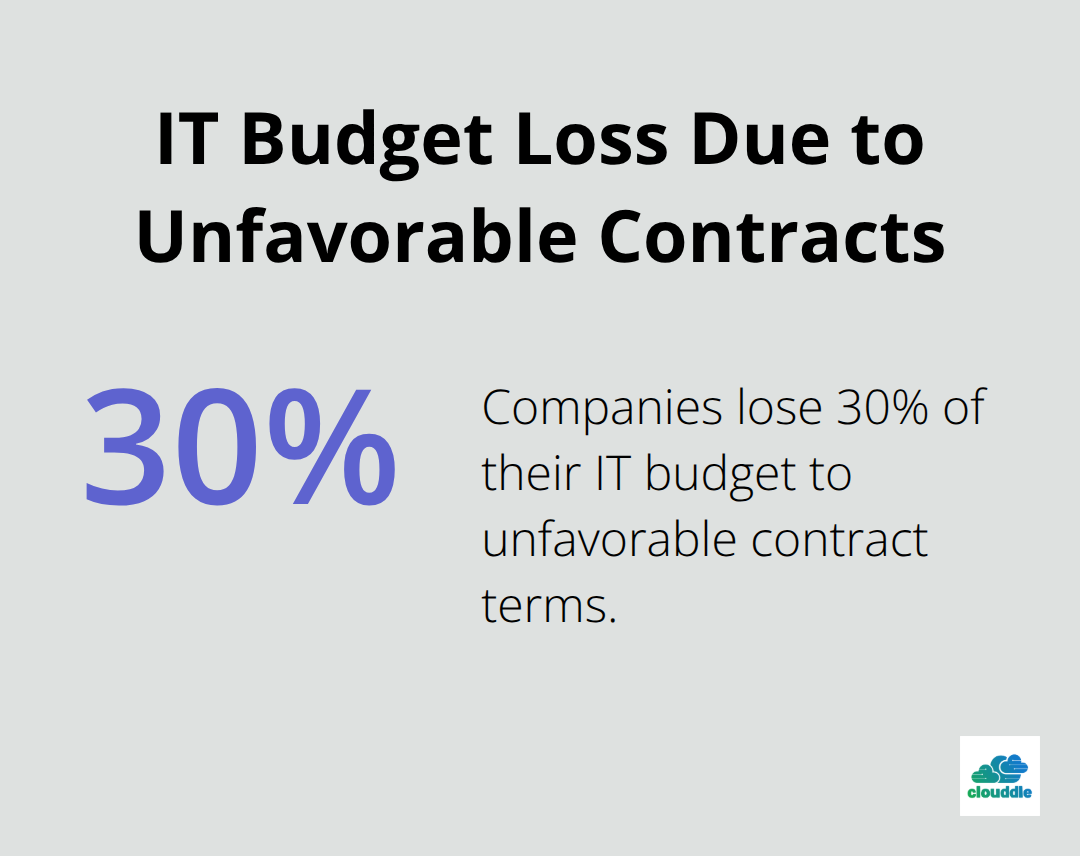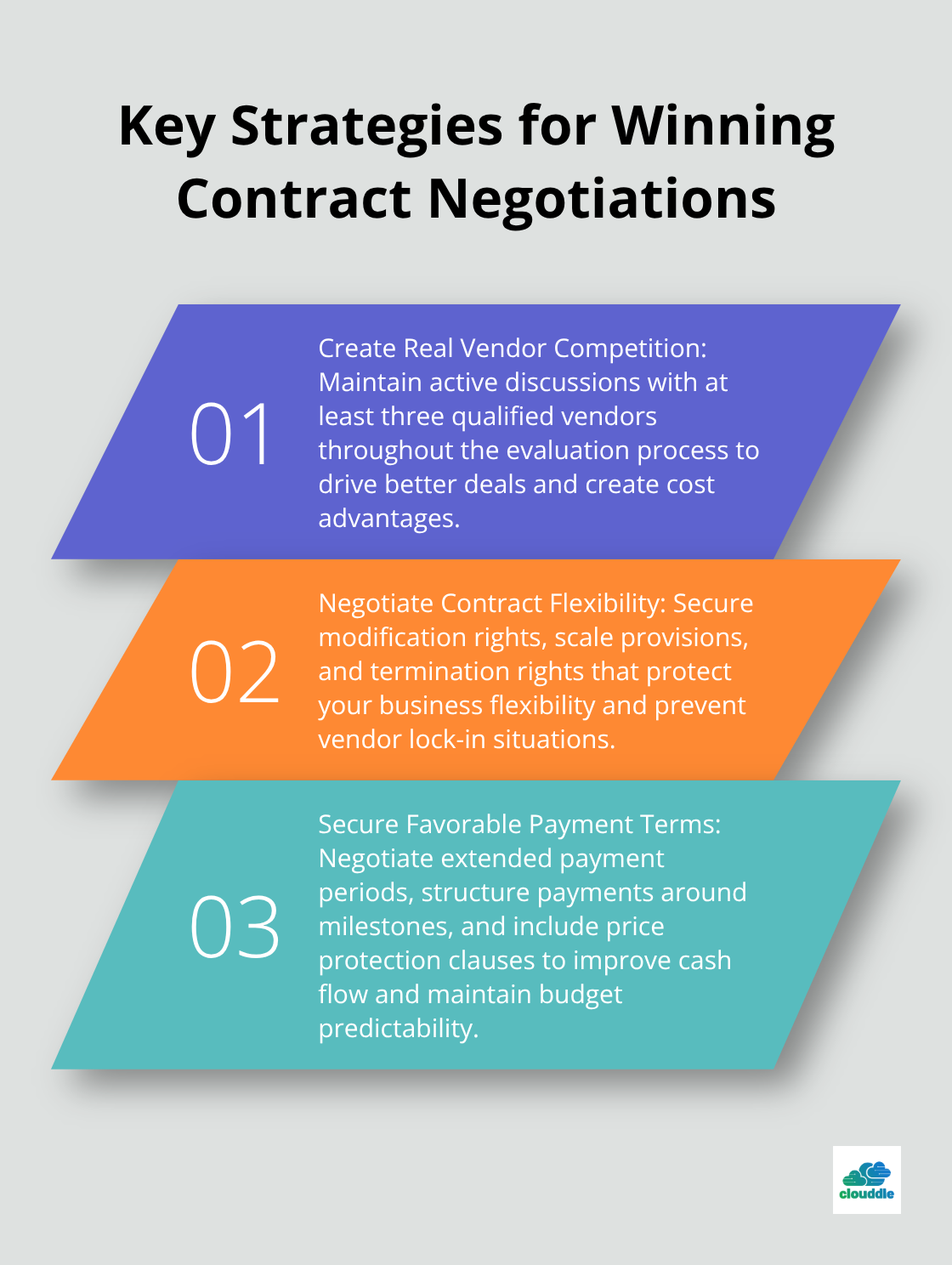IT vendor contracts can make or break your technology investments. Poor negotiations often lead to budget overruns, service gaps, and vendor lock-in situations that cost businesses millions annually.
We at Clouddle have seen companies lose 30% of their IT budget to unfavorable contract terms. The right negotiation strategy transforms these agreements from financial burdens into competitive advantages.

What Contract Terms Actually Matter
Most IT vendor contracts contain 50-80 pages of legal text, but only 12 key terms determine your success or failure. Payment schedules, liability caps, and termination clauses control 90% of contract disputes according to McKinsey research. Smart buyers focus their negotiation energy on these high-impact areas rather than get lost in standard boilerplate language.
Service Level Guarantees That Have Teeth
Service Level Agreements without financial penalties are worthless promises. Demand 99.9% uptime guarantees with automatic credits of 10-25% monthly fees for each hour of downtime. Amazon Web Services sets the gold standard with tiered penalty structures that increase with longer outages.
Your SLA should include response time commitments, resolution timeframes, and escalation procedures with named contacts. Performance metrics must be measurable through third-party tools, not vendor self-reports. Include monthly performance reports with detailed root cause analysis for any service failures.
Price Models That Protect Your Budget
Size-based price models punish growth and can increase costs by 300% as your organization expands. Transaction-based models create unpredictable monthly bills that spike during peak usage periods (especially problematic for seasonal businesses). Outcome-based models align vendor incentives with your business results and typically reduce total costs by 15-30% compared to traditional models.
Negotiate annual price caps of 3-5% regardless of usage increases. Lock in current rates for multi-year agreements with built-in benchmarks that adjust rates if market prices drop significantly. Include detailed breakdowns of all fees, implementation costs, and potential overage charges before you sign any agreement.
Termination Rights That Give You Power
Exit clauses protect you from vendor lock-in situations that trap businesses for years. Negotiate termination rights for convenience with 30-60 day notice periods (not just for cause). Include data portability requirements that force vendors to provide your information in standard formats within 30 days of contract end.
Avoid automatic renewal clauses longer than one year. These preparation strategies will position you to negotiate from strength rather than desperation.
How Do You Research Before Negotiating

Gather Competitive Intelligence
Market research transforms weak positions into powerful leverage points. IT analysts enhance vendor management and contract negotiations through data analysis, risk assessment, and strategic insights. Collect price data from at least five vendors, even if you prefer your current supplier. This competitive intelligence becomes your primary weapon during price discussions.
Industry reports from Gartner and Forrester provide detailed cost breakdowns for specific IT services. Peer networks through industry associations reveal real-world experiences with vendor contracts. Document every quote you receive with detailed feature comparisons and hidden fee structures. Most vendors inflate initial quotes by 15-25% and expect negotiations that bring prices down to their target levels.
Define Your Business Requirements
Your business requirements define negotiation success more than vendor capabilities. Map out your technical needs, budget constraints, and growth projections for the next three years before any vendor meetings begin. Create a scoring matrix that weights features based on actual business impact rather than vendor marketing promises.
Security requirements, integration capabilities, and scalability needs should drive your evaluation process, not flashy demonstrations. Focus on features that solve real business problems rather than impressive but unnecessary add-ons that inflate costs without adding value.
Build Your Negotiation Team
Assemble your negotiation team around three core roles: technical expert who understands implementation requirements, financial analyst who calculates total cost of ownership, and legal counsel who protects against unfavorable terms. The technical expert prevents vendors from overselling unnecessary features, while the financial analyst identifies hidden costs that inflate budgets by 30-40% over contract lifespans.
Your legal counsel should review standard vendor terms before negotiations begin and identify problematic clauses that favor supplier interests over your business needs. This team approach prevents costly mistakes and strengthens your position when vendors present complex contract terms.
These preparation steps position you to negotiate from strength rather than desperation. With solid research and clear requirements in hand, you can now implement specific tactics that force vendors to compete for your business.
How Do You Win Contract Negotiations

Create Real Vendor Competition
Vendor competition drives better deals more than any other negotiation tactic. Maintain active discussions with at least three qualified vendors throughout your evaluation process, even after you select a preferred supplier. This competitive pressure creates significant cost advantages through strategic procurement approaches. Share general price ranges between vendors without revealing specific details or creating bidding wars that damage relationships.
Schedule vendor meetings within the same week to maintain momentum and prevent delays that favor incumbent suppliers. Document all proposals with identical evaluation criteria and present comparable alternatives during final negotiations. Vendors offer their best terms when they believe competitors remain viable options, not when they sense desperation or single-source preferences.
Negotiate Contract Flexibility That Protects Your Business
Standard vendor contracts favor suppliers through restrictive terms that limit your business flexibility. Negotiate modification rights that allow technology changes, user additions, and service level adjustments without penalty fees or lengthy approval processes. Include scale provisions that accommodate business growth without expensive renegotiations or automatic price increases that can significantly impact your budget over time.
Demand termination rights for convenience with maximum 60-day notice periods and complete data portability within 30 days of contract end. Avoid automatic renewal clauses longer than 12 months and negotiate annual contract reviews that adjust terms based on performance metrics and market conditions. These flexibility provisions prevent vendor lock-in situations that trap businesses in outdated agreements.
Secure Payment Terms That Improve Cash Flow
Payment terms impact your cash flow more than headline prices in most IT contracts. Negotiate extended payment periods of 45-60 days instead of standard 30-day terms, which improves working capital by 15-25% annually. Structure payments around project milestones and performance achievements rather than calendar dates that favor vendor cash flow over service delivery.
Annual payment discounts of 5-10% offset extended payment terms while maintaining vendor relationships. Include price protection clauses that prevent mid-contract increases and benchmark provisions that adjust rates downward if market prices decline significantly (especially important during economic uncertainty). These financial protections maintain budget predictability while maximizing your negotiation leverage through consolidating your purchasing power.
Final Thoughts
Strategic preparation, competitive leverage, and focus on business-critical terms drive successful IT vendor contracts. Companies that master these fundamentals reduce IT costs by 20-30% while they secure better service levels and contract flexibility. The biggest mistake organizations make involves acceptance of vendor standard terms without pushback.
Over 60% of enterprise contracts still originate on counterparty templates, which creates unfavorable conditions that persist for years. Another critical error involves price negotiations alone while organizations ignore payment terms, exit clauses, and performance penalties that determine long-term value. Cross-functional teams with technical, financial, and legal expertise provide the foundation for effective contract discussions.
We at Clouddle help businesses navigate complex IT vendor contracts through our managed IT and networking solutions. Our transparent pricing and flexible contract terms adapt to your business needs without negotiation headaches. Transform your vendor relationships from cost centers into competitive advantages through strategic contract negotiations that protect your interests while they foster productive partnerships.


